On the table: Dinner with Manuel Cervantes Cespedes, Ben Aranda & Chris Lasch
Emerging Voices winners discuss constraint, minimalism, and how to "client-proof" a building.
The League’s annual Emerging Voices program recognizes eight firms with distinct design voices, each invited to lecture throughout the month of March. Following each night of lectures, the evening’s two presenting firms were joined at dinner by prominent architects, critics, and others in the field for informal and lively conversations.
What follows is the first night’s conversation (edited and condensed), in which Manuel Cervantes Cespedes of CC ARQUITECTOS, Ben Aranda and Chris Lasch of Aranda\Lasch, and other dinner guests discuss the benefits of constraint, varied definitions of minimalism, and how to “client-proof” a building.

Twenty guests gathered for dinner and dialogue following Emerging Voices lectures by Manuel Cervantes Cespedes of CC ARQUITECTOS and Ben Aranda and Chris Lasch of Aranda\Lasch
Anne Rieselbach, The Architectural League: This series emphasizes the voice of practitioners. How would you describe your voice?
Ben Aranda, Aranda\Lasch: I don’t know if we have a fully formed voice. We have a couple hunches about who we are and where we’re going. The bigger and more challenging the opportunities get, we’re finding a way to actually be architects. That’s coming after ten years of trying to be architects, doing installations and furniture, which are very much about the formation of a voice, at least in this city. Finding our voice as architects is basically trying to be true to what we did early on — finding how to not compromise or give in to challenges while still putting something out there.
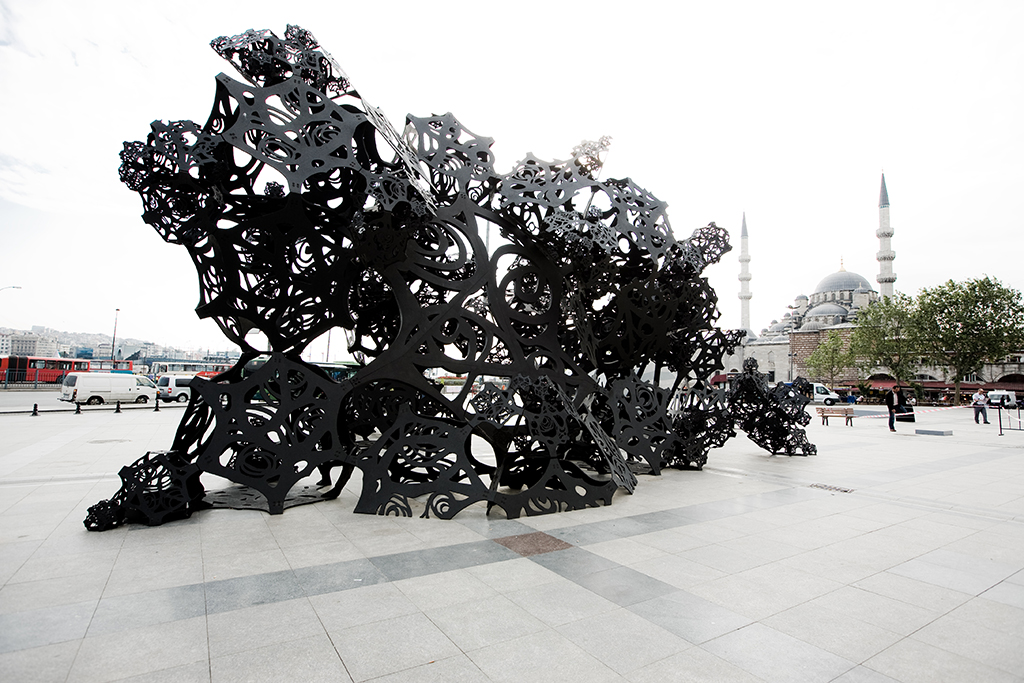
The Morning Line, a collaboration between Aranda\Lasch and Matthew Ritchie | Photo by Jakob Polacsek
As an undergraduate, a teacher told me, “You’re not going to get your first building built until you’re 40.” I thought that was absolutely ridiculous. But sure enough, 20 years later we finally got our first building. We’re happy that we’re finally getting to where we’re at.
Manuel Cervantes Cespedes, CC ARQUITECTOS: With our voice, we’re trying to create consciousness about our society — in Mexico, as a country, and in Mexico City — and our real needs and problems. Sometimes architects forget our responsibility as community members and we avoid the hard part of our work. That part is very important, especially in Mexico City. So many architects are making flashy projects, trying to get on the international radar. We are trying to create a more conscious, probably more silent, voice that comes from our heritage. I think that my voice has an international perspective, but always with a local root.
Rieselbach: You’ve partially answered the second question, but I’m going to throw it back to you guys: as emerging firms, what do you see as the advantages and challenges to practicing in today’s economic, professional, and intellectual climate?
Chris Lasch, Aranda\Lasch: I don’t think we could do what we’ve done at any time before just a couple years ago. We talk a lot about how technology has reinvigorated the way that we design and build architecture. But the new lines of communication that technology opens up are probably most important, at least for our practice.
We have two small offices across the country from one another, and I don’t think we would have been able to create something so seamless without the communication and cloud technologies that just until a little while ago weren’t available — or were only available to big corporate companies. As a small shop, we can keep it lean and expand our footprint yet still keep the work close to the source. That’s part of what’s enabling us to move into this next phase of our practice with a consistent approach.
Rieselbach: Manuel, in your lecture you stressed that you’re really working at both ends, with major transit-oriented development projects and with private commissions. How do you move between the two?
Cervantes: There’s a huge issue with corruption and other social problems in Mexico, and in architecture it can snowball and dismantle everything — it takes part of the budget, materials, construction solutions, and our time. Sometimes we spend very little time thinking and designing because we spend the whole time building on site. Our strategy is to get problems resolved at the beginning of the process so to avoid confrontations at the construction site or discussions with clients over the budget. This strategy is meant to deal with the social issues and with the lack of professional and intellectual capacity from some of the government officials.
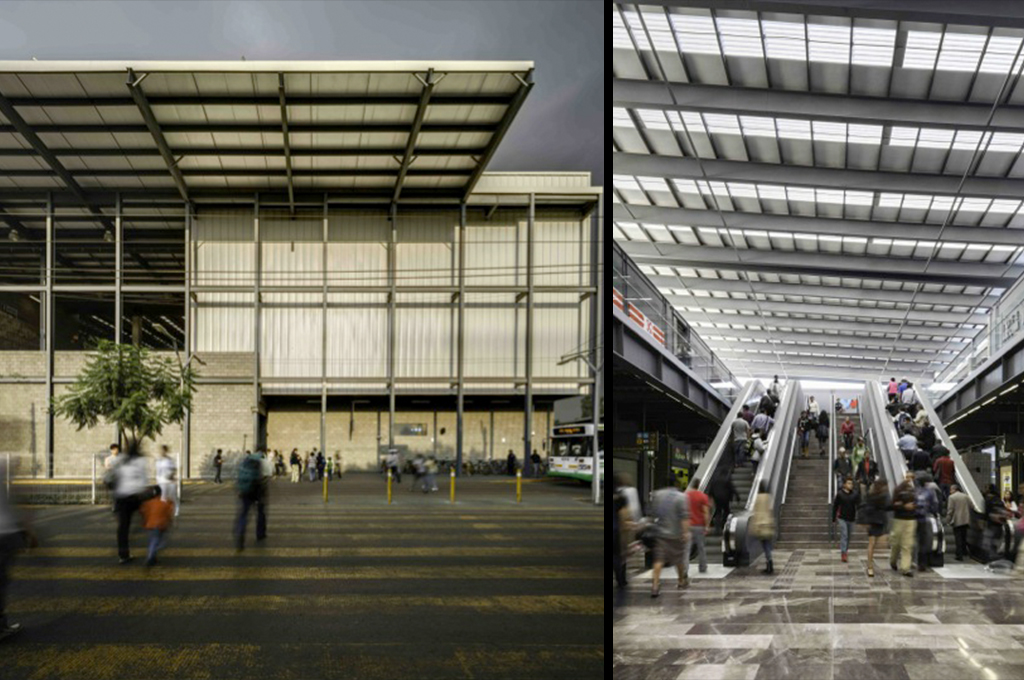
El Rosario, a mixed-use development centered on a bus terminal in Mexico City, by Manuel Cervantes Cespedes | Photo by Rafael Gamo
The El Rosario project was basically a bet with the client. I told him that I wanted to design a building that was “client-proof.” The client was one who really understands how Mexico works, and he’s very, very careful in thinking about how everything needs to come together — on the financial side and with the governmental relationship. That’s very important. But he’s also always giving opinions, changing things. Our goal was to create a building that was totally pure, without any additions or superfluous finishes. I learned with him the responsibility and consciousness needed on a public project, and I have taken that experience to the private sector. Our idea is to create projects that can defend themselves on the site.
Rosalie Genevro, The Architectural League: That speaks to one of the buzzwords right now in architecture, the idea of the “agency” of the architect: what is the realm and scope of the architect? Manuel, your work is very localized in a specific place and set of constraints. Ben and Chris’s work is, I think, much more universal in ambition. I wonder what each of you would say, as well as the other architects at the table, about the agency of the architect and how that plays out either in a universalized or a localized condition.
Lyn Rice, Rice+Lipka Architects: I find that interesting, because my take on the universal versus the local was exactly the opposite. In two different ways, both firms presented work with a tie to the past. Ben and Chris’s work is very interested in technology and what it can do to propel architecture into the future, which I think is highly specific to this moment — so in a way less universal. With your idea of the ruin, achieved through a generative means and through parametrics, it’s amazing that you go forward to get back. Whereas Manuel’s work expands somehow, in a timeless way, to bridge the past and the future. Manuel, you described almost suppressing the self and your moment in time to achieve timelessness, which is not just about going forward but having a link to the past as well. There’s substance to your work that bridges over where you are, a kind of suppression of your own identification.
But I know exactly what you’re saying, Rosalie, so I can see it both ways. What I see as common in both of them is great sensitivity rather than a top-down strategy, developed in one case from technologies and knowledge of the past, and in the other, from the immediate context.
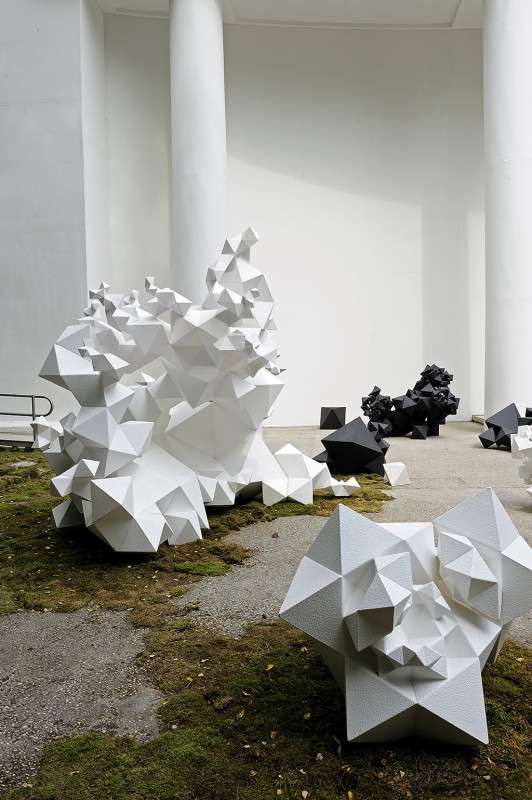
Modern Primitives, an installation by Aranda\Lasch | Photo courtesy of the firm
Louise Harpman, Specht Harpman Architects: Ben and Chris, you have this real love of geometry — of math, of rules and logic — and interest in what these systems, when you put them through their paces, can yield. It’s rich. You’re pursuing questions with rigor and enthusiasm and reckless abandon.
Lasch: That kind of encapsulates the tension that we always feel with our projects: the tension between being exuberant and constraining oneself to produce something that’s more serene, or stable.
Aranda: I feel like there’s this implication that Manuel is about rigor, minimalism, sparse use of resources, and elegance, while our practice is about a representation of technology that is more elaborate or complex — that minimalism or rigor is somehow a more appropriate representation of something timeless. I just want to challenge that, because I don’t think it’s that polar. When Manuel showed the image of the horse, I don’t know if you noticed but it caused a gasp in the audience. We were all really moved by the white horse —
Cervantes: It was a unicorn!

The “unicorn” in the Orchid Pavilion by Manuel Cervantes Cespedes | Photo by Rafael Gamo
Aranda: Right, a unicorn! There’s clearly a sensibility that allows for maximum impact moments between things that are very wild and things that are very abstract. And we really shoot for that, too. And we do it through what we think is an efficiency of resource. For instance, most of our projects are built out of one element, one block. They grow in a way that’s sometimes independent from us, and we like that. There’s a wildness to how they work and grow.
I think that this dichotomy between simplicity and complexity is over in the discipline of architecture now. There are clearly no more dichotomies like that with the way that we work as a society, with the technologies we use and ways we communicate. We can appreciate the similarities, but I also want to question that difference that is being put on the table.
Adam Yarinsky, Architecture Research Office: I was thinking about that as well. Both of your practices inhabit this continuum and blurred boundary between nature and culture. You, Ben and Chris, do it through investigations of mathematics and through this interest in the ruin, which I find fascinating. Similarly in your work, Manuel, there’s this way in which the city, and the areas outside the city that are not as developed, permeate the buildings. The architecture is at once apart from but also completely subsumed by the context in which it’s located.
The terrain that you’re both navigating is kind of fluid between what were formerly thought of as being oppositional conditions.
Walter Chatham, Walter Chatham Architect: One of the thoughts that sprang into my head that unites the work was the fact that the object is no longer the supreme, free-standing worshipped totem standing alone in the field. I really appreciated the ruin metaphor because, to me, a ruin is something that was an object that became either less or more than an object through the passage of time. I think that so much of what blights our landscape today are these object buildings. So I applaud both paths that you’re taking, and understand that you’re seeking to make buildings that are fragments, or things that subsist in the landscape so that they’re not dominating the landscape. I thought it was truly admirable the way you both subsumed this “heroic architect” myth, and I look forward to seeing more of that in the future.
Aranda: Manuel, I feel like you were implying that there are tendencies in Mexican architecture to create wow architecture. And perhaps that you’re then trying to develop a more silent voice?
Cervantes: Well, you started your lecture with how technology and communication influence your approach. I don’t have your kind of technology and resources. My strategy is to use what we have. Really I think it’s the same approach but with different tools: we use what we got. At the end of the day, we’re looking for the same thing, you know?
Aranda: Building labor is tremendously expensive in the US, and we’re typically forced to use very cheap materials. A lot of our tools are actually technologies to inflect what are quite cheap materials and give them some quality that lifts them from this cheapness. But you’re able to deal with what I think are luxurious materials: solid stone, solid wood. While you talk about the tools that we have, I actually see the tools that you have as something that I would love to access. There seem to be possibilities in Mexico that we can’t access here.
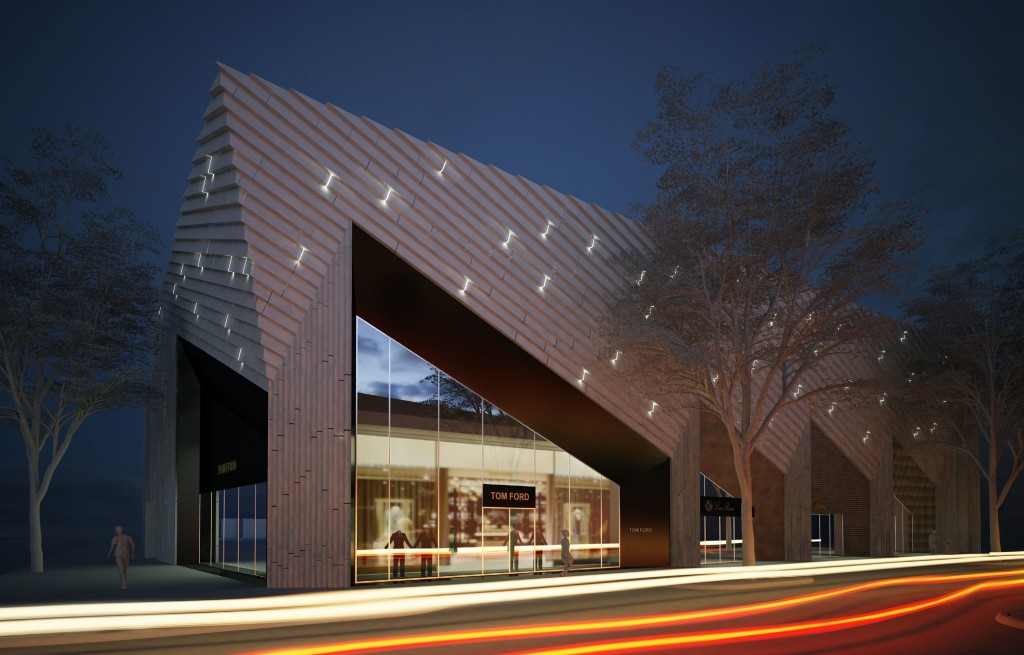
The Art Deco Building by Aranda\Lasch, currently under construction in Miami’s Design District | Image courtesy of the firm
Cervantes: I did a project in Miami and found out that I couldn’t do things in the handmade manner with the same materials here. Your regulations are too rigid; what I do in Mexico is probably illegal here. There was a lot of frustration with my design because of that.
Harpman: Did it get built?
Cervantes: Yeah, and I don’t like it. It was a fight between what I was wiling to design and what it was possible to fabricate in Miami. They looked at my blueprints and said, “Those materials, are you kidding me?” That’s an advantage that we have in Mexico sometimes.
Chris Gonya, designer and real estate developer: Manuel, you mentioned that you deal with a lot of corruption. But with any project, you’re always working for somebody, and our job is to take ideas and bring them to physical reality. There’s a lot of corruption that happens in that process, and not only politically and monetarily. So, is that just a natural part of the process, maybe not something specific to just Mexico?
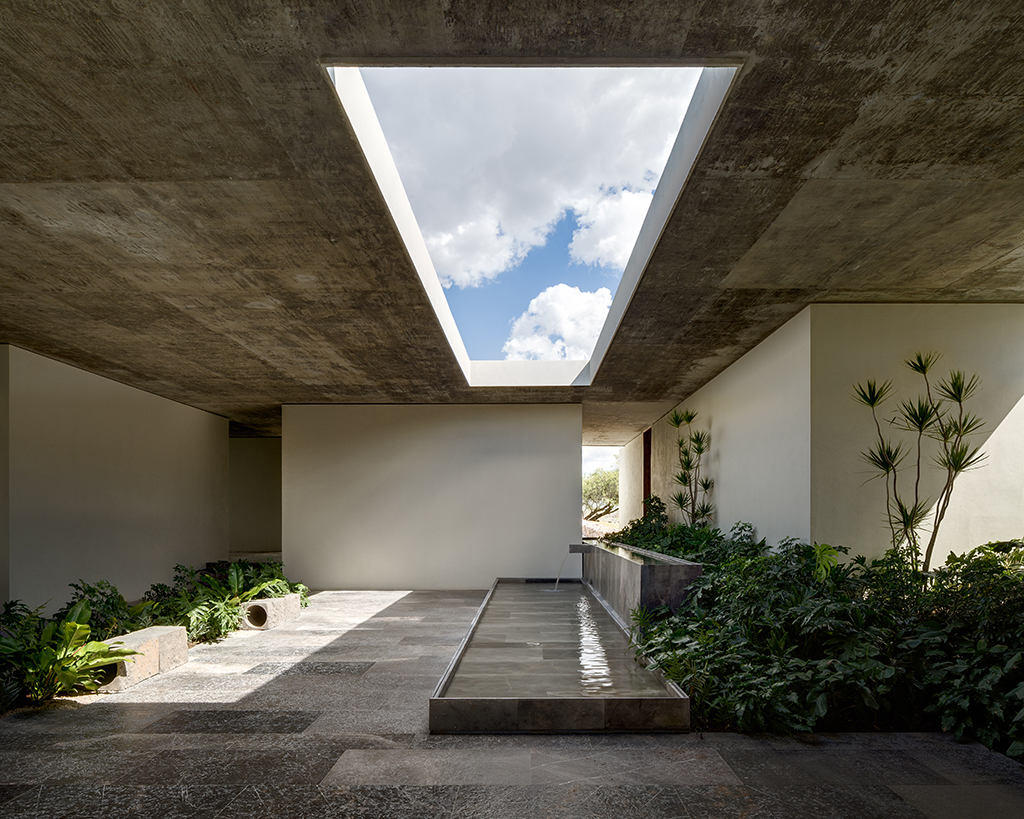
Next hydroponic factory by Manuel Cervantes Cespedes | Photo by Rafael Gamo
Cervantes: Yesterday we were talking about the documentary Sixteen Acres, which tells the story behind the Ground Zero project. You can see what happens with Daniel Libeskind’s design. He won the commission, but now you visit that place and there is nothing from his original project there. You can see the struggle between the Port Authority, the clients, the tenants. So it happens in countries that don’t have corruption like in Mexico.
I remember a Renzo Piano lecture in which he said that architecture is always a battle between competing forces. Those could be corruption, political issues, or community interests. So by getting all the information, all those issues in one place and finding the middle ground, we make peace before construction in order to avoid confrontation at the site. A friend of mine described this as designing to avoid compromising projects in the process.
El Rosario is a good example. The shape of shopping malls, from Victor Gruen to today, is a shape that gets in the middle of the design process. You have the cinema complex, and then the huge boxes for department stores. And at the end, you’ve got a strange shape that doesn’t have to be anything with a design process. So I decided to design a flexible, simple structure to create order in that matter. To create something that can expand or shrink without compromising the architecture. As an architect, sometimes we think that we are the architects. But in these huge projects, the architect is just the last one standing at the end of the auditorium.
Gonya: Do you think it makes for a better project?
Cervantes: I don’t know if it makes a better project, but it avoids confrontations at the site.
Lasch: We think about corruption as a kind of generic degradation of a project, from the idea to its realization. It strikes me that our strategies start from a similar impulse but have totally different results. Ben and I also try to read in constraints at the beginning of a project. Because our work is largely systems-based, those constraints are read into the system as a way to open it up and keep it flexible. It can then adjust to unforeseen demands as the project goes along without losing any fidelity. But I also admire your approach of the client-proof design. Instead of reading in those constraints and using them as a way to open up the process, you use it as a way to close it down and to armor the project from meddling clients. I like this idea that the project is so perfect, so pure, that there is no other way that the project could proceed. We should do that.
Manuel Cervantes Cespesdes is principal of Mexico City-based CC ARQUITECTOS. Benjamin Aranda and Chris Lasch are principals of Tucson- and New York City-based Aranda\Lasch.
